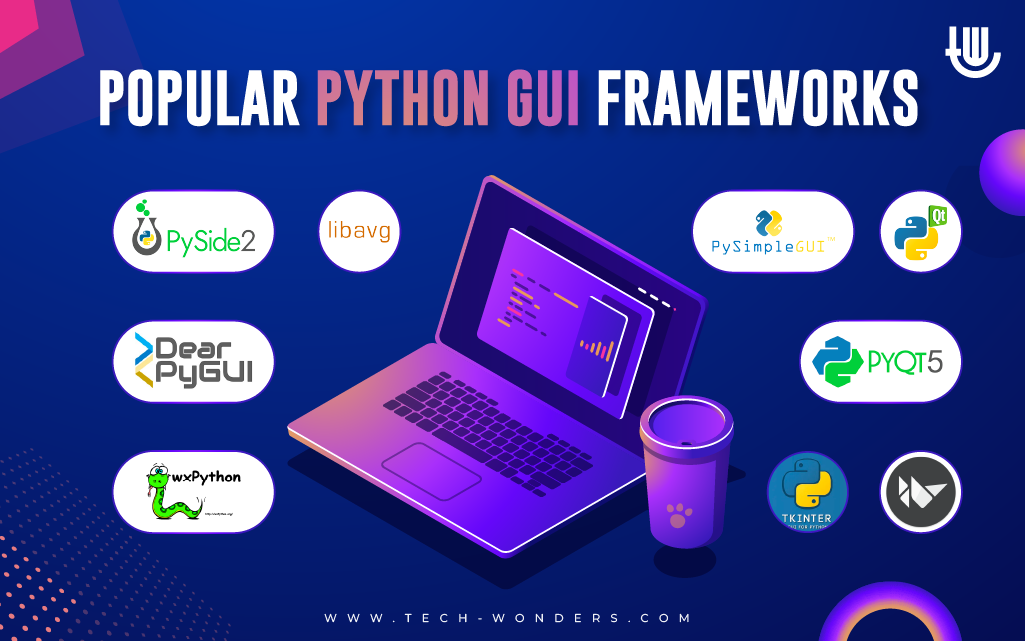
In the contemporary digital environment Graphic User Interface (GUI) hold paramount importance in software development, facilitating smooth interactions. Python’s widespread appeal, stemming from its adaptability and user-friendliness, has firmly established it as prominent contended in GUI development. It provides a wide array of library that helps when you hire Python developers to enrich user experiences by harmoniously blending aesthetics and functionality, ensuring seamless navigation and personalized interactions that resonate with users on a deep level. As Python continues to influence the evolution of GUI development, it paves the way for boundless possibilities, enabling developers to craft visually striking, user-focused applications that redefine the essence of technological experiences.
In the dynamic realm of software development, Graphical User Interfaces (GUIs) have emerged as the pivot for intuitive interactions with applications. Python’s prominence as a preferred programming language is a result of its simplicity and adaptability, propelling it to the forefront of GUI development. By providing an array of various potent frameworks, Python caters to diverse developer needs, welcoming both beginners and seasoned experts. Striving for a harmonious fusion of aesthetics and functionality, these frameworks enhance user experiences, forging deeper connections between users and applications.
The soaring popularity of Python in GUI development unlocks a realm of possibilities for creating captivating user experiences. As technology relentlessly advances, Python’s pervasive impact on the GUI development landscape is poised to expand further, ushering in endless opportunities for developers to redefine the dynamics of user-technology interactions.
By crafting visually compelling and user-centric applications, developers have the potential to revolutionize the sphere of GUI design, forging a future where technology seamlessly integrates with human experiences. Embracing this evolution, developers must remain at the forefront of innovation, leveraging Python’s strengths to create interfaces that transcend conventional boundaries and elevate the art of GUI development to new heights.
With a focus on elevating user experiences, GUI frameworks like Tkinter, PyQt5, Kivy, and PySimpleGUI serve as invaluable tools for developers seeking to create applications that leave a lasting impression. The amalgamation of aesthetic appeal and seamless functionality drives the creation of interfaces that effortlessly engage users. Python’s versatility empowers developers to explore novel approaches and integrate cutting-edge technologies, such as AI-driven personalization and immersive augmented reality experiences.
As the digital landscape evolves, Python’s prowess in GUI development will undoubtedly play a pivotal role in shaping the future of user interactions with technology. By embracing the boundless potential of Python GUI frameworks, developers embark on a journey to redefine the boundaries of creativity, sparking a new era of captivating, user-centric applications that resonate with users across the globe.
Let’s take a look at the popular python GUI frameworks.
Best Python GUI Frameworks

Following are some of the most popular Python GUI Frameworks available in the industry.
PyQt5
PyQt5 stands as a powerful and widely utilized Python binding designed for the Qt framework, a robust C++ GUI library. This framework facilitates the creation of cross-platform applications, granting them a native look and feel, thus making it a highly favored choice for Python GUI development. PyQt5 boasts extensive features, encompassing widgets, layouts, event handling, and multithreading support, which empower developers to construct intricate and feature-rich GUI applications. Its comprehensive documentation and the presence of an active community further amplify its appeal, rendering PyQt5 a versatile and dependable framework for crafting visually engaging and highly responsive user interfaces in Python.
Tkinter
Tkinter serves as a widely utilized and user-friendly GUI toolkit bundled with the Python programming language, rendering it a favoured option for graphical application development. Its popularity stems from its simplicity and ease of use, which empowers developers, including beginners, to design basic GUI applications with remarkable ease swiftly. Tkinter boasts a rich array of widgets, such as buttons, labels, and entry fields, which facilitate the effortless creation of interactive interfaces. Despite lacking some of the more advanced features found in other frameworks, Tkinter’s cross-platform compatibility ensures smooth operation on various operating systems. Furthermore, the framework benefits from an extensive and supportive community, making it a dependable and accessible option for those exploring GUI development with Python.
Kivy
Kivy represents a versatile and forward-thinking Python framework specially crafted for developing multitouch applications, interactive kiosks, and games. It makes for an excellent alternative for mobile applications and projects that require immersive user experiences because to its focus on touch-enabled interfaces and strong multimedia features. With Kivy, developers can create apps for a variety of devices because it is compatible with so many operating systems, including Windows, macOS, Linux, Android, and iOS. For those attempting to create aesthetically appealing and interactive GUIs in Python, Kivy offers a wide range of tools and widgets that simplify the process of building cross-platform apps.
Py GUI
Py GUI is a lesser-known Python GUI framework that offers both immediate mode and retained mode GUI capabilities. The primary objective of Py GUI is to offer a simple and user-friendly approach to GUI application development, catering specifically to quick prototyping and more straightforward projects. While Py GUI may not provide an extensive feature set like some other frameworks, its ease of integration and simplicity make it a suitable solution for specific use cases. Its strengths lie in its ability to serve as a hassle-free option for developers seeking swift development for specific projects. Nevertheless, it presents a viable option for when you’re looking to hire dedicated developers seeking a quick and hassle-free GUI development experience in Python.
PyQT
PyQt stands as a potent Python binding for the esteemed Qt framework, a C++ GUI library, granting developers the ability to craft cross-platform applications with a native appearance and behavior. This renders it a favored option for GUI development in Python. PyQt offers a comprehensive range of features, encompassing widgets, layouts, event handling, and multithreading support, bestowing developers with the means to create intricate and feature-rich GUI applications. It’s extensive documentation and active community support serve to further elevate its allure, establishing PyQt as a versatile and dependable framework for building visually captivating and responsive user interfaces in Python.
wxPython
The C++ library known as wxWidgets, which offers native-looking interfaces on a variety of platforms, has a Python binding called wxPython. Developers can create GUI apps quickly using this framework because it places a strong emphasis on usability and versatility. For Python developers of all skill levels looking to build aesthetically pleasing and responsive user interfaces, wxPython’s huge widget library, multi-threading capability, and cross-platform compatibility make it a desirable option. Its robust capabilities and compatibility with various operating systems position wxPython as a popular framework for developing applications that seamlessly run across different platforms.
PySimpleGUI
PySimpleGUI is a Python GUI framework that truly lives up to its name, streamlining the process of crafting graphical user interfaces. It presents a high-level interface, abstracting away complexities, making it an ideal choice for developers seeking to build straightforward and rapid GUI applications. The framework’s versatility shines through its support for both tkinter and Qt backends, empowering developers to choose according to their preferences and requirements. With its user-friendly nature and ease of learning, PySimpleGUI caters to developers of all expertise levels, providing a seamless and efficient approach to designing visually captivating and user-centric interfaces in Python.
Pyside 2
PySide2 stands as a potent Python module, serving as the official binding for the esteemed Qt for Python project, thus granting developers effortless access to the Qt framework. PySide2 makes it possible to build strong, cross-platform graphical user interfaces because to its smooth integration with Qt’s wide capabilities. The ability to create adaptable and aesthetically pleasing programs that appeal to a wide range of users is ensured by compatibility with Python 2 and Python 3 as well as support for Windows, macOS, and Linux. With its active development and ongoing improvements, PySide2 has established itself as a viable option for Python GUI development, providing programmers with a variety of tools to speed up the development of interactive and user-centric interfaces.
LibAvg
Libavg represents a high-level multimedia framework that empowers developers to design interactive graphical user interfaces. Despite being less renowned compared to some counterparts, Libavg distinguishes itself through its exceptional multimedia capabilities, rendering it a prime option for applications with a strong focus on multimedia content. Developers can harness Libavg’s features to create immersive and interactive user experiences, especially in scenarios where seamless multimedia integration holds the key to an application’s success. With its versatility and robust set of tools, Libavg proves to be a valuable asset in crafting captivating GUI applications that revolve around multimedia content.
Conclusion
In summary, Python GUI frameworks are essential for developers to craft captivating and intuitive graphical user interfaces. Embracing the simplicity of Tkinter, the versatility of PyQt5, the multimedia prowess of Kivy, and the user-friendly approach of PySimpleGUI, each framework caters to diverse development needs. Python’s growing influence in GUI development provides limitless possibilities to create visually striking and interactive interfaces. By harnessing the potential of these frameworks, developers can embark on a transformative journey, enriching user experiences across platforms and reshaping the way technology is embraced in the modern world.

Author Bio: Ronak Patel is a CEO and Founder of Aglowid IT Solutions, an ever-emerging top web and mobile app development company with a motto of turning clients into successful businesses. He believes that client’s success is company’s success and so that he always makes sure that Aglowid helps their client’s business to reach to its true potential with the help of his best team with the standard development process he set up for the company.